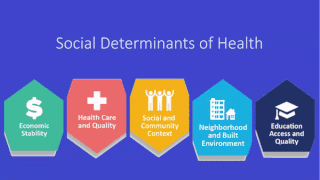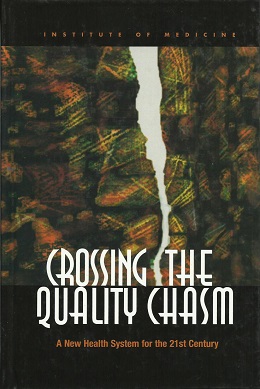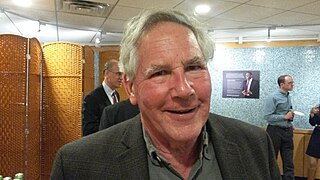Health equity arises from access to the social determinants of health, specifically from wealth, power and prestige. Individuals who have consistently been deprived of these three determinants are significantly disadvantaged from health inequities, and face worse health outcomes than those who are able to access certain resources. It is not equity to simply provide every individual with the same resources; that would be equality. In order to achieve health equity, resources must be allocated based on an individual need-based principle.

The social determinants of health (SDOH) are the economic and social conditions that influence individual and group differences in health status. They are the health promoting factors found in one's living and working conditions, rather than individual risk factors that influence the risk for a disease, or vulnerability to disease or injury. The distributions of social determinants are often shaped by public policies that reflect prevailing political ideologies of the area.

In demography and medical geography, epidemiological transition is a theory which "describes changing population patterns in terms of fertility, life expectancy, mortality, and leading causes of death." For example, a phase of development marked by a sudden increase in population growth rates brought by improved food security and innovations in public health and medicine, can be followed by a re-leveling of population growth due to subsequent declines in fertility rates. Such a transition can account for the replacement of infectious diseases by chronic diseases over time due to increased life span as a result of improved health care and disease prevention. This theory was originally posited by Abdel Omran in 1971.
Steven A. Schroeder is Distinguished Professor of Health and Health Care at the University of California, San Francisco (UCSF), where he also heads the Smoking Cessation Leadership Center. He served as the president and CEO of the Robert Wood Johnson Foundation from 1990 to 2002. Schroeder is known for his work in promoting smoking cessation strategies.

Diana M. Zuckerman is an American health policy analyst who focuses on the implications of policies for public health and patients' health. She specializes in national health policy, particularly in women's health and the safety and effectiveness of medical products. She is the President of the National Center for Health Research and the Cancer Prevention and Treatment Fund.
Christine K. Cassel is a leading expert in geriatric medicine, medical ethics and quality of care. She is planning dean of the new Kaiser Permanente School of Medicine. Until March 2016, she was president and CEO of the National Quality Forum. Previously, Cassel served as president and CEO of the American Board of Internal Medicine (ABIM) and the ABIM Foundation.

Crossing the Quality Chasm: A New Health System for the 21st Century is a report on health care quality in the United States published by the Institute of Medicine (IOM) on March 1, 2001. A follow-up to the frequently cited 1999 IOM patient safety report To Err Is Human: Building a Safer Health System, Crossing the Quality Chasm advocates for a fundamental redesign of the U.S. health care system.
James Michael McGinnis is a US physician, epidemiologist, and long-time contributor to national and international health programs and policy, including continuous policy responsibilities for leadership in disease prevention and health promotion through four US Government Administrations. An elected member of the Institute of Medicine of the National Academies, he currently also serves as IOM Senior Scholar, as well as executive director of its Roundtable on Value & Science-Driven Health Care.
Judith A. Salerno, MD, MS is a physician executive and the President of the New York Academy of Medicine.

Norman Daniels is an American political philosopher and philosopher of science, political theorist, ethicist, and bioethicist at Harvard University and the Harvard T.H. Chan School of Public Health. Before his career at Harvard, Daniels had built his career as a medical ethicist at Tufts University in Medford, Massachusetts, and at Tufts University School of Medicine, also in Boston.

The National Center for Health Research is a Washington, D.C.-based non-profit organization founded in 1999, providing health-related services such as providing free information and training based on research findings; educating policy makers and working with the media. The President of the organisation is Diana Zuckerman. The primary program is The Cancer Prevention and Treatment Fund, which utilises an online health hotline.

Barbara Starfield was an American pediatrician. She was an advocate for primary health care worldwide. Her academic and professional life was almost fully dedicated to the Johns Hopkins University.
The social determinants of health in poverty describe the factors that affect impoverished populations' health and health inequality. Inequalities in health stem from the conditions of people's lives, including living conditions, work environment, age, and other social factors, and how these affect people's ability to respond to illness. These conditions are also shaped by political, social, and economic structures. The majority of people around the globe do not meet their potential best health because of a "toxic combination of bad policies, economics, and politics". Daily living conditions work together with these structural drivers to result in the social determinants of health.
Lester Breslow was an American physician who promoted public health. Breslow's career had a significant impact. He is credited with pioneering chronic disease prevention and health behavior intervention. His work with the Human Population Laboratory in the Alameda County Study established the connection between mortality and lifestyle issues like exercise, diet, sleep, smoking, and alcohol. He has been called "Mr. Public Health".
Health policy and management is the field relating to leadership, management, and administration of public health systems, health care systems, hospitals, and hospital networks. Health care administrators are considered health care professionals.
Rashi Fein was an American health economist termed "a father of Medicare" in the United States and "an architect of Medicare," was Professor of Economics of Medicine, Emeritus, in the Department of Global Health and Social Medicine at Harvard Medical School, and the author of the book Medical Care, Medical Costs: The Search for a Health Insurance Policy.
Population health, a field which focuses on the improvement of the health outcomes for a group of individuals, has been described as consisting of three components: "health outcomes, patterns of health determinants, and policies and interventions". Policies and Interventions define the methods in which health outcomes and patterns of health determinants are implemented. Policies which are helpful "improve the conditions under which people live". Interventions encourage healthy behaviors for individuals or populations through "program elements or strategies designed to produce behavior changes or improve health status".
Nancy Elinor Adler is an American health psychologist. She is the Lisa and John Pritzker Professor of Medical Psychology at the University of California, San Francisco (UCSF) and director of UCSF's Center for Health and Community Sciences. Adler is known for her research on health behaviors, health disparities, and social determinants of health.

Kirsten Bibbins-Domingo is an American epidemiologist and physician. She is the 17th Editor in Chief of the Journal of the American Medical Association (JAMA) and the JAMA Network. She is Professor of Epidemiology and Biostatistics and the Lee Goldman, MD Endowed Professor of Medicine at University of California, San Francisco. She is a general internist and attending physician at San Francisco General Hospital.

Fitzhugh Mullan was an American physician, writer, educator, and social activist. He participated in the founding of the Student Health Organization, the National Coalition for Cancer Survivorship, Seed Global Health, and the Beyond Flexner Alliance. Mullan was a professor of Health Policy and Management and of Pediatrics at the George Washington University and the George Washington University Health Workforce Institute, now renamed the Fitzhugh Mullan Institute for Health Workforce Equity. He was an elected member of the National Academy of Medicine.








